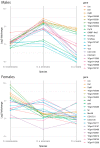Constitutive and Plastic Gene Expression Variation Associated with Desiccation Resistance Differences in the Drosophila americana Species Group
- PMID: 32019054
- PMCID: PMC7073762
- DOI: 10.3390/genes11020146
Constitutive and Plastic Gene Expression Variation Associated with Desiccation Resistance Differences in the Drosophila americana Species Group
Abstract
Stress response mechanisms are ubiquitous and important for adaptation to heterogenous environments and could be based on constitutive or plastic responses to environmental stressors. Here we quantify constitutive and plastic gene expression differences under ambient and desiccation stress treatments, in males and females of three species of Drosophila known to differ in desiccation resistance. Drosophila novamexicana survives desiccation trials significantly longer than the two subspecies of Drosophila americana, consistent with its natural species range in the desert southwest USA. We found that desiccation stress reduces global expression differences between species-likely because many general stress response mechanisms are shared among species-but that all species showed plastic expression changes at hundreds of loci during desiccation. Nonetheless, D. novamexicana had the fewest genes with significant plastic expression changes, despite having the highest desiccation resistance. Of the genes that were significantly differentially expressed between species-either within each treatment (>200 loci), constitutively regardless of treatment (36 loci), or with different species-specific plasticity (26 loci)-GO analysis did not find significant enrichment of any major gene pathways or broader functions associated with desiccation stress. Taken together, these data indicate that if gene expression changes contribute to differential desiccation resistance between species, these differences are likely shaped by a relatively small set of influential genes rather than broad genome-wide differentiation in stress response mechanisms. Finally, among the set of genes with the greatest between-species plasticity, we identified an interesting set of immune-response genes with consistent but opposing reaction norms between sexes, whose potential functional role in sex-specific mechanisms of desiccation resistance remains to be determined.
Keywords: Drosophila; RNA-seq; desiccation.
Conflict of interest statement
The authors declare no conflict of interest.
Figures




References
-
- Baldwin J.M. Development and Evolution. Macmillan; New York, NY, USA: 1902.
-
- Simpson G.G. The Baldwin Effect. Evolution. 1953;7:110–117. doi: 10.1111/j.1558-5646.1953.tb00069.x. - DOI
-
- Waddington C.H. Canalization of Development and the inheritance of acquired characters. Nature. 1942;150:563–565. doi: 10.1038/150563a0. - DOI
Publication types
MeSH terms
Substances
LinkOut - more resources
Full Text Sources
Molecular Biology Databases

